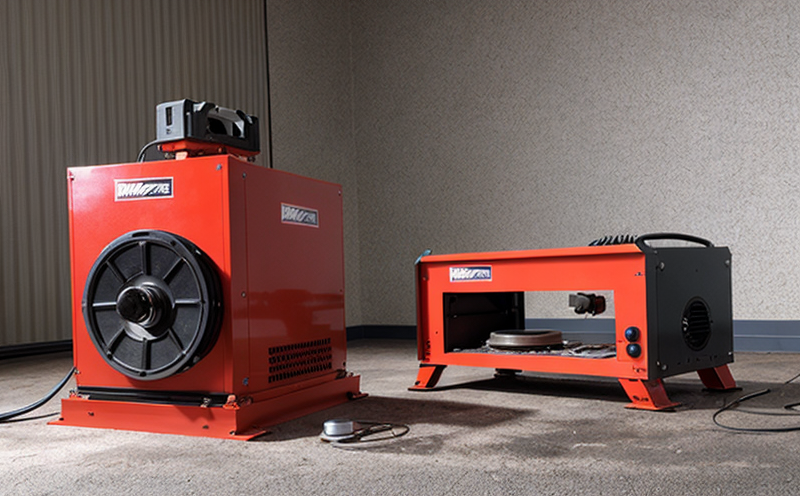Shock, Impact & Durability Vibration Testing
In the realm of product development and quality assurance, the ability to simulate real-world environmental conditions is paramount. Shock, impact, and durability vibration testing are crucial processes that ensure products can withstand the rigors they will encounter during their lifecycle. This service focuses on the evaluation of materials, components, and assemblies under controlled shock, impact, and vibratory environments to assess their resistance to damage or failure.
Shock testing involves subjecting a product to sudden changes in velocity, which can be caused by external impacts such as dropping, bumping into objects, or being struck. Impact testing measures the energy absorbed during such events. Durability vibration testing ensures that products can continue functioning effectively after experiencing prolonged vibratory conditions.
The primary goal of these tests is to ensure the reliability and safety of products in harsh environments. Industries like automotive, aerospace, electronics, and manufacturing heavily rely on this service to validate their designs before mass production. By conducting thorough testing, manufacturers can identify potential weaknesses early in the development process, thereby reducing costly reworks and recalls.
Our state-of-the-art facilities are equipped with advanced vibration test systems capable of simulating a wide range of shock, impact, and vibratory conditions. These systems are designed to replicate real-world scenarios accurately, ensuring that each product undergoes realistic stress testing. Our team of experienced engineers works closely with clients to understand their specific requirements and tailor the tests accordingly.
When conducting these tests, we follow international standards such as ISO 2631-1:2014 for human vibration exposure limits in the workplace, ASTM E985 for impact testing, and EN 1097-2 for ship construction. These standards provide a benchmark for consistency and reliability across industries.
Our approach to shock, impact, and durability vibration testing involves several key steps:
Initial consultation: We begin by discussing the client's requirements and objectives with them. This helps us understand the specific conditions under which the product will operate.
Sample preparation: Products undergo thorough preparation to ensure they are in optimal condition for testing. This includes cleaning, labeling, and ensuring that all components are assembled correctly.
Test setup: Our engineers set up the test rig according to the agreed-upon parameters. This involves selecting the appropriate vibration frequency range, amplitude, and duration.
Data collection: During testing, we collect extensive data on the product's performance under various conditions. This includes measurements of displacement, acceleration, and force.
Analysis & reporting: After completing the tests, our team analyzes the collected data to determine how well the product performed. We then prepare a detailed report summarizing the findings and any recommendations for improvement.
The results of these tests are invaluable in ensuring that products meet quality standards and perform reliably under expected conditions. By incorporating this testing into their development process, manufacturers can significantly reduce risks associated with failures in the field.
Our comprehensive approach to shock, impact, and durability vibration testing ensures that clients receive accurate and reliable test results. Whether you're developing a new product or validating an existing design, our services provide the assurance needed to meet your quality goals.
Applied Standards
The following international standards are applied during shock, impact, and durability vibration testing:
ISO 2631-1:2014 - This standard provides guidelines for the measurement and evaluation of human exposure to whole-body vibration in the workplace. It helps ensure that products do not expose users to harmful levels of vibration.
ASTM E985 - This test method specifies procedures for determining the impact properties of materials by means of a standard hammer-drop test. It is widely used in industries where impact resistance is critical, such as automotive and electronics manufacturing.
EN 1097-2: This European standard covers the construction requirements for ships. While primarily aimed at shipbuilders, it also provides valuable insights into how to design products that can withstand harsh environmental conditions.
By adhering strictly to these standards, we ensure that our tests are consistent and reliable across different industries and applications.
International Acceptance and Recognition
The services provided here are widely recognized and accepted by global regulatory bodies. Our compliance with international standards ensures that the results of these tests are valid and credible worldwide.
Clients can be assured that their products will meet stringent quality requirements, regardless of where they are sold or manufactured. This is particularly important for companies operating in multiple countries or exporting their goods internationally.
Our reputation for delivering accurate and reliable results has earned us a strong presence in the international market. We work with clients from various sectors including automotive, aerospace, electronics, and manufacturing to help them meet global standards and regulations.
Competitive Advantage and Market Impact
By incorporating our shock, impact, and durability vibration testing into their product development process, companies can gain a significant competitive edge. Products that have undergone rigorous testing are more likely to perform well in the field, reducing the risk of failure or recall.
A robust quality assurance program supported by comprehensive testing ensures higher customer satisfaction and loyalty. This is particularly important in industries where product reliability directly impacts user experience.
The results of these tests can also be used to demonstrate compliance with regulatory requirements, helping companies enter new markets more easily. In a highly competitive global market, such advantages are crucial for maintaining and growing a company's market share.





